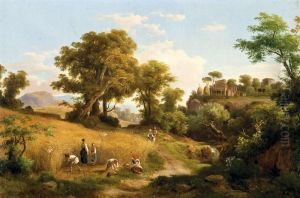Karoly Ede Alexy Paintings
Károly Ede Alexy, born in 1866 in Hungary, was a distinguished artist whose work spanned the late 19th and early 20th centuries, a period rich in artistic innovation and the emergence of new styles across Europe. Although not as widely recognized internationally as some of his contemporaries, Alexy's contributions to the art world, particularly in the realm of sculpture and teaching, have left a lasting legacy in his native country and beyond. His career was marked by a dedication to the craft of sculpture and a commitment to education, influencing a generation of Hungarian artists through his teachings and works.
Alexy's artistic journey began at the Hungarian University of Fine Arts, where he honed his skills and developed a deep understanding of classical and modern art forms. His style, characterized by a blend of naturalism and emerging modernist tendencies, reflected the dynamic changes occurring in the art world at the time. He was particularly known for his sculptures, which often captured the human form with a sensitivity and attention to detail that brought his subjects to life. His works were not only appreciated for their aesthetic qualities but also for their ability to convey deeper emotional and philosophical themes.
Throughout his career, Károly Ede Alexy actively participated in the vibrant cultural life of Hungary, contributing to exhibitions and engaging in artistic discussions that helped shape the direction of Hungarian art. His influence extended beyond his own creations; as a respected educator, Alexy played a crucial role in nurturing the talents of young artists at the Hungarian University of Fine Arts. His teaching philosophy emphasized the importance of mastering traditional techniques while also encouraging experimentation and the exploration of new ideas.
Alexy's contributions were recognized with several awards and honors during his lifetime, and his works became part of national collections, including those of prestigious museums and galleries across Hungary. Despite the challenges of World War I and the interwar period, which impacted many artists of his generation, Alexy remained committed to his artistic vision and to the development of the arts in Hungary.
Károly Ede Alexy passed away in 1936, leaving behind a rich body of work that continues to be studied and admired. His legacy is not only in the sculptures and artworks he created but also in the generations of artists he inspired through his teaching and mentorship. His life and career serve as a testament to the enduring power of art to reflect and shape human experience across time and place.
